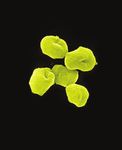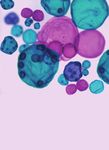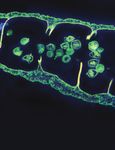The Effectiveness of Triple Dose Albendazole in Treating Soil Transmitted Helminths Infection
←
→
Page content transcription
If your browser does not render page correctly, please read the page content below
Hindawi
Journal of Parasitology Research
Volume 2019, Article ID 6438497, 4 pages
https://doi.org/10.1155/2019/6438497
Research Article
The Effectiveness of Triple Dose Albendazole in Treating Soil
Transmitted Helminths Infection
Saleha Sungkar ,1 Kartika Q. Putri,1 Muhammad I. S. Taufik,1
Meutia N. Gozali,1 and Pratiwi Sudarmono2
1
Department of Parasitology, Faculty of Medicine, Universitas Indonesia, Jakarta, Indonesia
2
Department of Microbiology, Faculty of Medicine, Universitas Indonesia, Jakarta, Indonesia
Correspondence should be addressed to Saleha Sungkar; salehasungkar@yahoo.com
Received 28 October 2018; Revised 5 January 2019; Accepted 20 January 2019; Published 4 February 2019
Academic Editor: Bernard Marchand
Copyright © 2019 Saleha Sungkar et al. This is an open access article distributed under the Creative Commons Attribution License,
which permits unrestricted use, distribution, and reproduction in any medium, provided the original work is properly cited.
Soil transmitted helminths (STH) infection is a major health problem in tropical countries such as Indonesia. Albendazole is an
effective and widely used anthelmintic agent to treat STH; however, it is not effective towards T. trichiura and its effectiveness
varies between populations. Hence, we conducted a study to determine the effectiveness of triple dose albendazole in children of
Perobatang village, Southwest Sumba, Indonesia. A pre-post study was carried out in Perobatang village on July 2016. Children aged
1-15 years old were enrolled in the study and asked to collect stool samples which were then examined using Kato-Katz method. The
children infected with STH were given albendazole 400 mg for three consecutive days. From 246 subjects examined, 192 (78%) were
positive for any STH consisting of T. trichiura (64%), A. lumbricoides (60%), and hookworms (10%). After treatment, the prevalence
of STH decreased significantly (McNemar test, p2 Journal of Parasitology Research
mainly due to the difficulty in accessing clean water which effects, patients and/or the parents were questioned for any
can only be obtained from artesian well, located far from clinical complaints after taking the drugs.
residential areas. Hence, clean water is only used sparingly for
drinking and cooking, rarely for bathing and hand hygiene. In 2.6. Outcome Assessment. To determine the effectiveness of
addition, people are used to free defecation as their traditional albendazole triple dose, we compared the cure rate (CR) and
houses are ill-equipped with latrines and sanitation. eggs reduction rate (ERR) calculated using the formula below.
Perobatang village is a small rural community located 70 CR
km from the capital of Southwest Sumba district (Tambo-
laka). In 2015, it has an area of 4360 hectares with 315 families number of subjects infected with STH who were cured
=
and a total population of 1459 (498 children, 231 early- number of infected subjects who were treated
adults, and 630 adults aged >40 years). The predominant
× 100%
occupations are fishermen and farmers. There is no primary (1)
health centre (PHC) facility in the village. The nearest PHC ERR
is located almost 3 km away in Bondokodi subdistrict. The
mean EPG before treatment − mean EPG after treatment
village was chosen due to high risk factors of STH infection =
mean EPG before treatment
(free defecation, poor hand washing habit, inaccessible clean
water sources, low socioeconomic status), and the lack of × 100%
mass drug administration (MDA) program with albendazole We calculated the total CR and ERR along with CR and ERR
conducted in the village. for each species of worms found in the feces samples.
2.2. Study Design. This study used pre- and post-study 2.7. Data Analysis. The treatment was considered effective if
design conducted in Perobatang village, Southwest Sumba, CR was >90% and ERR was >90%. To obtain the prevalence
Indonesia, in July 2016. of STH before and after treatment, data was analyzed using
McNemar test in SPSS version 20 and the difference of EPG
2.3. Study Subjects. The subjects were all children in the vil-
before and after treatment was analyzed using Wilcoxon test.
lage, aged 1-15 years, who got parental permissions; children
For all tests, a p-value of 0.05 was considered the limit of
with fever were excluded.
statistical significance and 95% confidence intervals (CIs)
2.4. Data Collection. The village chief ’s residence was con- were calculated as appropriate.
verted into a makeshift clinic. Baseline data was collected on
the first week of July 2016 prior to treatment and followed 2.8. Ethical Clearance. This study has obtained ethical
up two weeks after treatment (to study the effectiveness approval from Ethical Committee of Faculty of Medicine,
of anthelmintic, the best interval between treatment and Universitas Indonesia (Ref. No. 771/UN2.F1/ethic/2015).
resampling should be 10-14 days).
On the first day, the subjects and their parents were 3. Results
given informed consent. Demographic characteristics were 3.1. Subjects Characteristics. All children (498 children) in the
obtained from the parents or the subjects. They were also village were recruited. Among those children, 246 returned
given explanation on procedure of collecting the fecal sam- the pot with the samples and were all examined for STH
ples. infection. A total of 192 children were positive for STH and
To collect the fecal samples, thumb-sized feces were put treated at the start of the study. Table 1 shows that most
into 10 cc pot. Stool pots were labeled with the identity of subjects were between 5 and 15 years old (72%) and the
the subjects: name, code data, gender, and age. The next prevalence of STH was 78% consisting of T. trichiura (64%),
day, the subjects were asked to return the samples to the A. lumbricoides (60%), and hookworm (10%).
researchers. Kato-Katz thick smears method was prepared
from each sample [6] and the samples were examined under 3.2. Cure Rate and Egg Reduction Rate. Table 2 shows that
a light microscope (40X magnification). Number of eggs two weeks after the treatment, the prevalence of A. lumbri-
per gram (EPG) of the fecal sample was recorded for each coides, T. trichiura, and hookworms decreased significantly
species of worms. If the result was negative in the first smear, (McNemar test, pJournal of Parasitology Research 3
Table 1: The characteristics of subjects in Perobatang village, 2016.
Characteristics Any STH T. trichiura A. lumbricoides Hookworm
Gender
Male, n=114 82 (33%) 67 (27%) 67 (27%) 14 (6%)
Female, n=132 110 (45%) 90 (37%) 81 (33%) 10 (4%)
Age
1 – 4 yo, n=69 51 (21%) 35 (14%) 40 (16%) 3 (1%)
5 – 15 yo, n=177 141 (57%) 122 (50%) 108 (44%) 21 (9%)
Total (n=246) 192 (78%) 157 (64%) 148 (60%) 24 (10%)
Table 2: The prevalence of STH and cure rate after intervention.
Prevalence
Species of Worm CR (95% CI)
Before After
A. lumbricoides 148 (60%) 5 (2%) 97% (90–100)
T. trichiura 157 (64%) 62 (25%) 61% (53–68)
Hookworms 24 (10%) 0 (0%) 100% (96–100)
Table 3: The comparison of EPG before and after intervention.
Mean EPG∗
Species of Worm ERR (95% CI)
Before After
A. lumbricoides 8.592 24 100% (99–100)
T. trichiura 1.344 120 91% (88–93)
Hookworms 24 0 100% (99–100)
∗Average number of eggs per gram of feces.
single dose anthelminthics to at-risk populations, especially and hookworm (92%); meanwhile for T. trichiura, the CR
school-age children [7, 8]. of triple dose albendazole was 56.2% and that of triple dose
In this study, we show the effectiveness of triple dose mebendazole was 70.7% [9].
albendazole in reducing the prevalence of STH. Prior to Randomized controlled trial conducted by Adegnika et
the intervention we found that the prevalence of the three al. [10] compared the albendazole single dose and repeated
types of worms was very high, especially among school- doses in the treatment of A. lumbricoides, T. trichiura, and
aged children as they spend more time outdoors compared hookworm. Adequate cure rates and egg reduction rates
to the younger children. Smaller children tend to spend above 85% were found with a single dose of albendazole for
more time carried by mothers, hence limiting their contact A. lumbricoides infection, 85% and 93.8%, respectively, while
with soil. Prevalence of each species of worm is more than two doses were necessary for hookworm infestation (92% and
50%, but not in hookworms (10%) because the prevalence 92%, respectively). However, while a 3-day regimen was not
of hookworm infection is higher in adults compared to sufficient to cure T. trichiura (CR 83%), this regimen reduced
children. Adults usually work in the farm where the soil is the number of eggs up to 90.6%. Treatment led to a reduction
loose while the children play in the yard of the house that of multiple infections and double or triple infections were rare
is clay. The clay soil is a suitable factor for the development after a treatment with one or two doses
of life cycles of STH, particularly A. lumbricoides and T. The reduction and the maintenance of low worm burden
trichiura, while hookworms prefer sandy soil for the aeration have an important impact on the health of the community.
larval development. The warm climate in this area is a The first sign of improvement is parasitological with a reduc-
supporting factor in the development of STH, especially for tion of heavy infection, then nutritional, with an increase
embryonation of STH eggs. in iron stores, followed by an increase in hemoglobin level
Our finding is similar to that of Steinman et al. [5] and finally by an increase in growth. At least two years
that reported efficacy of triple dose of albendazole 400 mg of intervention are normally required before an increase
compared to single dose albendazole and single dose or triple in hemoglobin becomes evident and even longer period
dose of mebendazole. The efficacy of albendazole is higher is required to exhibit improvement in growth. Improved
compared to mebendazole, except for T. trichiura. Triple indicators of school effects (school attendance, reenroll-
dose albendazole gave a high CR for A. lumbricoides (96.8%) ment, retention, and achievement) have been observed: iron4 Journal of Parasitology Research
load and increasing hemoglobin level, improving physical [2] J. Utzinger, R. Bergquist, R. Olveda, and X.-N. Zhou, “Important
growth and cognitive capacity, educational achievement, and helminth infections in southeast asia. diversity, potential for
reduced school absence [11]. control and prospects for elimination,” Advances in Parasitology,
Without significant environmental and health behavioral vol. 72, no. C, pp. 1–30, 2010.
improvement, reinfection will occur and may reach the same [3] S. Sungkar, A. P. N. Pohan, A. Ramadani et al., “Heavy burden
prevalence and intensity prior to the treatment. Jia et al. [12] of intestinal parasite infections in Kalena Rongo village, a rural
found that reinfection will occur in 6-12 months after the area in South West Sumba, eastern part of Indonesia: A cross
treatment, while Appleton et al. [13] reported that within five sectional study,” BMC Public Health, vol. 15, no. 1296, 2015.
months there had been a 75% reinfection of A. lumbricoides, [4] WHO, Guideline: Preventive Chemotherapy to Control Soil-
71% T. trichiura reinfection, and 28% reinfection of hook- Transmitted Helminth Infections in at-Risk Population Groups,
WHO, Geneve, Switzerland, 2017.
worm. Total reinfection will return within 12 months if no
retreatment is applied. [5] P. Steinmann, J. Utzinger, Z.-W. Du et al., “Efficacy of single-
dose and triple dose albendazole and mebendazole against STH
Since it is difficult to change environmental and health
and Taenia sp: a randomized controlled trial,” PLoS ONE, vol. 6,
behavioral patterns in Perobatang village, mass drug treat- no. 9, Article ID e25003, 2011.
ment is required every six months for at least five consecutive
[6] WHO, Action against Worms, WHO, Geneve, Switzerland,
years to control STH. Tun et al. [14] conducted a study in 2008.
Myanmar and found that 400 mg of albendazole every 6
[7] A. Degarege and B. Erko, “Association between intestinal
months for seven years succeeded in controlling STH even helminth infections and underweight among school children
without changing the subjects’ environmental and behavioral in Tikur Wuha Elementary School, Northwestern Ethiopia,”
practices. Journal of Infection and Public Health, vol. 6, no. 2, pp. 125–133,
Albendazole is effective in treating A. lumbricoides and 2013.
hookworm but not effective for T. trichiura. However, a high [8] T. Alelign, A. Degarege, and B. Erko, “Soil-transmitted helminth
ERR on albendazole can reduce environmental contamina- infections and associated risk factors among schoolchildren in
tion with T. trichiura eggs, and if mass treatment is carried Durbete town, northwestern Ethiopia,” Journal of Parasitology
out for more than 5 years, STH will be eliminated including T. Research, vol. 2015, Article ID 641602, 5 pages, 2015.
trichiura. In areas with high trichuriasis, albendazole should [9] A. Ash, A. Okello, B. Khamlome, P. Inthavong, J. Allen, and R. C.
be given in three consecutive days to enhance the elimination A. Thompson, “Controlling Taenia solium and soil transmitted
of T. trichiura. helminths in a northern Lao PDR village: Impact of a triple dose
albendazole regime,” Acta Tropica, vol. 174, pp. 171–178, 2017.
5. Conclusion [10] A. A. Adegnika, J. F. Zinsou, S. Issifou et al., “Randomized,
controlled, assessor-blind clinical trial to assess the efficacy
Triple dose albendazole is effective in reducing prevalence of single-versus repeated-dose albendazole to treat ascaris
of A. lumbricoides, T. trichiura, and hookworms in tropical lumbricoides, trichuris trichiura, and hookworm infection,”
remote area with limited clean water access, poverty, and poor Antimicrobial Agents and Chemotherapy, vol. 58, no. 5, pp. 2535–
2540, 2014.
education.
[11] WHO, Intestinal Worm, WHO, Geneva, Switzerland, 2016,
http://www.who.int/intestinal worms/epidemiology/en/.
Data Availability [12] T.-W. Jia, S. Melville, J. Utzinger, C. H. King, and X.-N. Zhou,
“Soil-transmitted helminth reinfection after drug treatment: a
The data used to support the findings of this study are systematic review and meta-analysis,” PLOS Neglected Tropical
included with this article. Diseases, vol. 6, no. 5, Article ID e1621, 2012.
[13] C. C. Appleton, T. I. Mosala, J. Levin, and A. Olsen, “Geo-
Conflicts of Interest helminth infection and re-infection after chemotherapy among
slum-dwelling children in Durban, South Africa,” Annals of
Authors declare no conflicts of interest. Tropical Medicine and Parasitology, vol. 103, no. 3, pp. 249–261,
2009.
Acknowledgments [14] A. Tun, S. M. Myat, A. F. Gabrielli, and A. Montresor, “Control
of soil-transmitted helminthiasis in Myanmar: Results of 7 years
Funding was obtained from Community Engagement Grant of deworming,” Tropical Medicine & International Health, vol.
(CEG) from Directorate of Research and Public Services, 18, no. 8, pp. 1017–1020, 2013.
Universitas Indonesia. Authors would like to thank the
head of the Perobatang village and other parties who have
supported this study.
References
[1] R. L. Pullan, J. L. Smith, R. Jasrasaria, and S. J. Brooker, “Global
numbers of infection and disease burden of soil transmitted
helminth infections in 2010,” Parasites & Vectors, vol. 7, no. 1,
article 37, 2014.International Journal of Journal of
Peptides Nucleic Acids
The Scientific International Journal of International Journal of
World Journal
Hindawi Publishing Corporation
Cell Biology
Hindawi Hindawi
Microbiology
Hindawi Hindawi
http://www.hindawi.com
www.hindawi.com Volume 2018
2013 www.hindawi.com Volume 2018 www.hindawi.com Volume 2018 www.hindawi.com Volume 2018 www.hindawi.com Volume 2018
Anatomy Biochemistry
Research International Research International
Hindawi Hindawi
www.hindawi.com Volume 2018 www.hindawi.com Volume 2018
Submit your manuscripts at
www.hindawi.com
Advances in Genetics
Bioinformatics
Hindawi
Research International
Hindawi
www.hindawi.com Volume 2018 www.hindawi.com Volume 2018
Advances in
Virolog y Zoology Stem Cells
International Journal of
International Journal of BioMed
Genomics
Hindawi Hindawi Hindawi
International
Hindawi
Research International
Hindawi
www.hindawi.com Volume 2018 www.hindawi.com Volume 2018 www.hindawi.com Volume 2018 www.hindawi.com Volume 2018 www.hindawi.com Volume 2018
Neuroscience
Journal
Enzyme Journal of Journal of
Research
Hindawi
Parasitology Research
Hindawi Hindawi
Marine Biology
Hindawi
Archaea
Hindawi
www.hindawi.com Volume 2018 www.hindawi.com Volume 2018 www.hindawi.com Volume 2018 www.hindawi.com Volume 2018 www.hindawi.com Volume 2018You can also read



























































